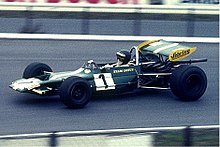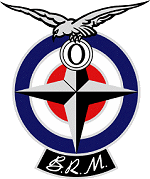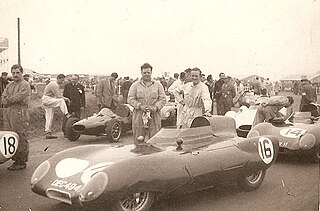
The Lotus 69 was an open-wheel formula racing car developed by Lotus in 1969 for use in Formula 2, Formula 3, and Formula Ford. [1]

The Lotus 69 was an open-wheel formula racing car developed by Lotus in 1969 for use in Formula 2, Formula 3, and Formula Ford. [1]
Since the Formula 2 regulations for 1970 provided for extensive changes to the vehicles, Dave Baldwin developed the Lotus 69 based on the Lotus 59 Formula 2 car. [2]

He left the basic Lotus 59 construction untouched and only changed the central monocoque section, which contained the two fuel tanks. The chassis mounts have been modified and the front has been adapted to the new regulations to reduce the radiator inlet. Since only engines up to a maximum of 1600 cc were allowed in Formula 2 from 1967 to 1971, the car received a 1.6-liter Cosworth FVA four-cylinder engine and a Hewland F.T.200 gearbox. [3]

The basic vehicle construction was designed in such a way that by adding other suspensions and brakes, and by changing the body parts and the wheels, the Lotus 69 could be built into a Formula 3 or Formula B- compliant racing car. [4]

With the increase in the displacement limit to 2000 cc in Formula 2, the racing cars were equipped with a Cosworth BDA engine in 1971. [5]
The Lotus 69F was built to Formula Ford regulations and featured a space frame chassis with a modified front end and narrower wheels than the Formula 2 and Formula 3 variants. It was delivered with 1.6-liter Ford/Lotus engines. [6]
A total of 57 racing cars were produced by the Lotus 69, of which eight cars were built for Formula 2. [7]
A Formula 2 vehicle was purchased by Pete Lovely and briefly converted into a Formula 1 car. He used this in 1971 at the Canadian Grand Prix and the US Grand Prix without success. [8]
The Lotus 69 was the last model developed and produced for customer use. In 1971 Colin Chapman closed Lotus Racing Ltd. and concentrated on Formula 1 motorsport with his works team.
Jochen Rindt won the first two races of the 1970 Formula 2 season with the Lotus 69 before concentrating on Formula One. The following year, Emerson Fittipaldi won five Formula 2 races with the car. [9]
In the two British Formula 3 championships in 1971, Dave Walker won 25 out of a total of 32 races with the racing car and thus won the two championship titles.
(key)
| Year | Entrant | Engine | Tyre | Driver | 1 | 2 | 3 | 4 | 5 | 6 | 7 | 8 | 9 | 10 | 11 | WCC Points | WCCPos. |
|---|---|---|---|---|---|---|---|---|---|---|---|---|---|---|---|---|---|
| 1971 | Pete Lovely Volkswagen Inc. | Ford Cosworth DFV 3.0 V8 | F | | RSA | ESP | MON | NED | FRA | GBR | GER | AUT | ITA | CAN | USA | 21* | 5th* |
| NC | NC |
* All points scored by other Lotus models

Cosworth is a British automotive engineering company founded in London in 1958, specialising in high-performance internal combustion engines, powertrain, and electronics for automobile racing (motorsport) and mainstream automotive industries. Cosworth is based in Northampton, England, with facilities in Cottenham, England, Silverstone, England, and Indianapolis, IN, US.

Formula Two is a type of open-wheel formula racing category first codified in 1948. It was replaced in 1985 by Formula 3000, but revived by the FIA from 2009–2012 in the form of the FIA Formula Two Championship. The name returned again in 2017 when the former GP2 Series became known as the FIA Formula 2 Championship.

Formula Three, also called Formula 3, abbreviated as F3, is a third-tier class of open-wheel formula racing. The various championships held in Europe, Australia, South America and Asia form an important step for many prospective Formula One drivers.

British Racing Motors (BRM) was a British Formula One motor racing team. Founded in 1945 and based in the market town of Bourne in Lincolnshire, it participated from 1951 to 1977, competing in 197 grands prix and winning seventeen. BRM won the constructors' title in 1962 when its driver Graham Hill became world champion. In 1963, 1964, 1965 and 1971, BRM came second in the constructors' competition.

The DFV is an internal combustion engine that was originally produced by Cosworth for Formula One motor racing. The name is an abbreviation of Double Four Valve, the engine being a V8 development of the earlier four-cylinder FVA, which had four valves per cylinder.
Vel's Parnelli Jones Racing, commonly referred to simply as Parnelli or VPJ, was a motor racing constructor and team from the United States. The team was formed in 1969 by former USAC racer Parnelli Jones and his business partner Velko "Vel" Miletich. Parnelli was initially solely concerned with USAC racing, where success came quickly; their driver Al Unser won the Indianapolis 500 race in 1970, driving a VPJ Colt, after leading 190 of the 200 racing laps. Unser went on to win the USAC championship. Unser repeated the Indy 500 win in 1971 with a new Colt built without the left side chassis offset that had been made illegal by 1971 rules, ending the season in fourth place in the USAC drivers points while teammate Joe Leonard won the championship.

The Lotus 49 was a Formula One racing car designed by Colin Chapman and Maurice Philippe for the 1967 F1 season. It was designed around the Cosworth DFV engine that would power most of the Formula One grid through the 1970s. It was one of the first F1 cars to use a stressed member engine combined with a monocoque to reduce weight, with other teams adopting the concept after its success. An iteration of it, the 49B, also pioneered the use of aerofoils to generate downforce.

The McLaren M23 was a Formula One racing car designed by Gordon Coppuck, with input from John Barnard, and built by the McLaren team. It was a development of the McLaren M16 Indianapolis 500 car. A Ford Cosworth DFV engine was used, which was prepared by specialist tuning company Nicholson-McLaren Engines. This helped push the DFV's horsepower output to around 490 bhp.

The Brabham BT49 is a Formula One racing car designed by South African Gordon Murray for the British Brabham team. The BT49 competed in the 1979 to 1982 Formula One World Championships and was used by Brazilian driver Nelson Piquet to win his first World Championship in 1981.

The Lotus 59 is a racing car built by Lotus Components Ltd. for the 1969 and 1970 seasons of Formula 2, Formula 3, Formula Ford and Formula B.

John Crosthwaite was an English race car designer and engineer, active in both the United Kingdom and the United States.

The HB is a series of 3.5-litre, naturally-aspirated V8 Formula One racing engines, designed, developed and produced by Cosworth, in partnership with Ford; and used between 1989 and 1994. The customer engines were used by Benetton, Fondmetal, McLaren, Lotus, Minardi, Footwork, Simtek, and Larrousse.

The March 811 is a Formula One car built by March Engineering and used by RAM Racing in the 1981 Formula One World Championship. Designed by Robin Herd, Gordon Coppuck, and Adrian Reynard, it was powered by the traditional 3.0 L (180 cu in) Ford-Cosworth DFV V8 engine. It initially used Michelin tyres, but eventually switched to Avon tyres at the 1981 French Grand Prix. It was March's first Formula One car since 1977.

The Brabham BT5, and its evolution, the Brabham BT8, are sports racing cars manufactured and developed by Brabham in 1963 (BT5) and 1964 (BT8), respectively. It won a total of 4 races, and achieved 10 podium finishes.

The Chevron B36 was a Group 6 prototype sports car, designed, developed, and built by British manufacturer Chevron Cars Ltd in 1976 and used in sports car racing until 1987. Over that time period, it won a total of 14 races, and achieved 43 podium finishes.

The Chevron B16 was a Group 4 sports prototype race car, designed, developed, and built in 1969 by the British racing car manufacturer Chevron Cars as a two-seater racing sports car for the makes world championship. Brian Redman won the very first outing, the 500 km (310 mi) race at the Nürburgring on September 7, 1969, at a time of 3:13:01.6 hours. The last victory with a Chevron B16 was achieved by Clemens Schickentanz on July 11, 1971, in the sports car race at the Norisring.
The Martin BM7, and its successor and derivative, the Martin BM8, are 2-liter sports prototype race cars, designed, developed, and built by British racing driver, automotive engineer, and mechanic, Brian Martin, in 1969 and 1970, respectively. They were constructed to compete in the European 2-Litre Championship sports car racing series. These cars were powered by a number of different engines, including a BMW M12/7, a Ford Motor Company-Cosworth FVC, and a Ford-Cosworth BDX, which all displaced around 2.0 L (120 cu in). These cars won a total of 8 races, and scored 20 podium finishes.

The Lola T210, and its evolution, the Lola T212, are Group 6 sports prototype race cars, designed, developed and built by British manufacturer Lola, for the newly created European 2-Litre sports car racing championship, in 1970.

The Lola T280, and its evolutions, the Lola T282, Lola T284, and Lola T286, are a series of 3-liter Group 5 sports prototype race cars, designed by Eric Broadley, John Barnard, and Patrick Head, and developed and built by British manufacturer and constructor Lola, for World Sportscar Championship sports car racing, between 1972 and 1976.
The Reynard F3000 cars are open-wheeled Formula 3000 cars, designed and developed by Malcolm Oastler, and constructed and built by British manufacturer Reynard Motorsport.